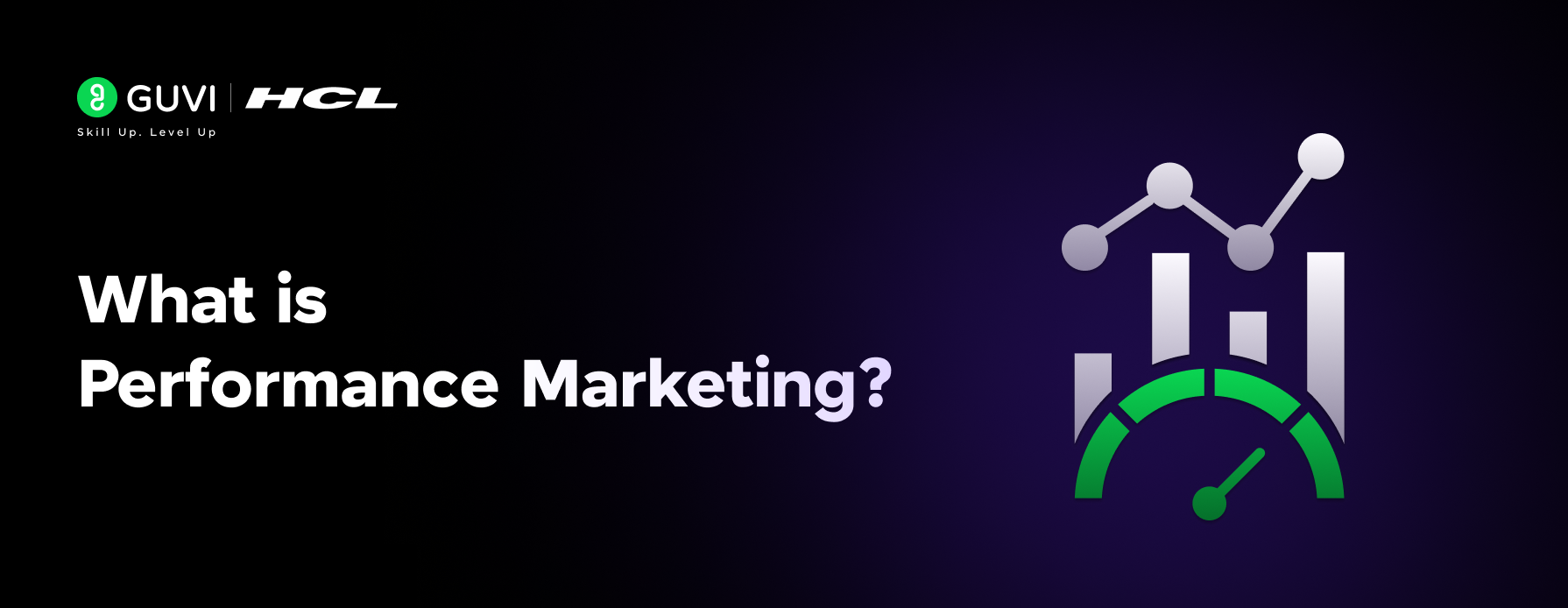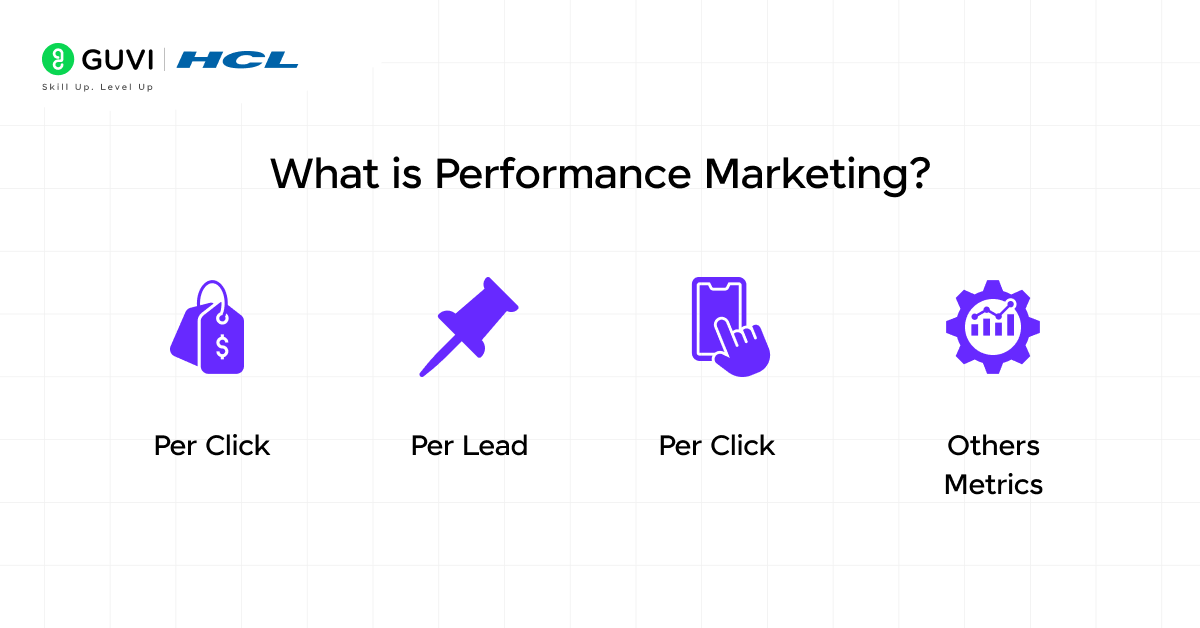
Performance Marketing 101: A Simplified Guide
Feb 23, 2025 6 Min Read 1481 Views
(Last Updated)
If you’ve ever scrolled through your favorite blog or browsed social media and seen an ad that is similar to your interests, you’ve likely witnessed performance marketing in action. But what exactly is performance marketing?
In today’s digital-first world, businesses demand marketing strategies that deliver measurable results. Enter performance marketing, a highly targeted, results-driven approach where you only pay for specific actions, like clicks, leads, or sales.
Understanding Performance Marketing is crucial if you are aspiring to become a digital marketer or someone who wants to understand digital economics. This article will help you learn everything related to it. So, let us get started!
Table of contents
- What is Performance Marketing?
- Why is it Called "Performance" Marketing?
- How Does Performance Marketing Work?
- Setting Goals
- Choosing the Right Channels
- Creating Campaigns
- Tracking and Attribution
- Optimization
- Paying for Results
- Measuring Success
- Key Channels in Performance Marketing
- Search Engine Marketing (SEM)
- Social Media Advertising
- Affiliate Marketing
- Email Marketing
- Influencer Marketing
- Career in Performance Marketing: A Brief Overview
- Tips for Getting Started with Performance Marketing
- Conclusion
- FAQs
- What is performance marketing?
- How does performance marketing differ from traditional marketing?
- What are the key channels used in performance marketing?
- Why is performance marketing important for businesses?
- How can a business get started with performance marketing?
What is Performance Marketing?

Performance marketing is a form of digital marketing where advertisers only pay for specific actions. Think clicks, leads, sales, or any other measurable activity that directly contributes to business growth. In other words, you’re paying for results and not just exposure.
Traditional advertising (like billboards or TV spots) often focuses on reaching as many people as possible, hoping some of them convert. Performance marketing flips the script by ensuring that you pay only when your marketing efforts yield tangible results.
Why is it Called “Performance” Marketing?
It’s all about accountability and outcomes. Advertisers track performance meticulously, measuring how well their campaigns are achieving goals. With the abundance of digital marketing tools, it’s now possible to know exactly how many people interacted with your ad, what they did next, and whether they took the desired action.
For example:
- If you’re running an online store, you might focus on sales as your key performance metric.
- If you’re building brand awareness, you might track clicks, impressions, or shares.
How Does Performance Marketing Work?

Performance marketing may sound straightforward, but its effectiveness lies in the details. Let’s break down each step of the process so you can understand how it works.
1. Setting Goals
Every performance marketing campaign starts with clear, measurable goals. The specific action you want users to take is called a Key Performance Indicator (KPI). Without defined KPIs, it’s impossible to measure success.
Common Goals in Performance Marketing:
- Clicks: Driving traffic to a website or landing page.
- Leads: Collecting information from potential customers (e.g., through forms or sign-ups).
- Conversions: Making a sale or achieving any other predefined action, like downloading an app or subscribing to a newsletter.
- Engagement: Increasing interactions such as likes, shares, or comments on social media.
Your goals will determine the channels, audience, and strategies you use in your campaigns.
2. Choosing the Right Channels
Performance marketing spans across several digital platforms, each catering to different audiences and offering unique advantages. Selecting the right channels is crucial for reaching your target audience.
Popular Channels for Performance Marketing:
- Search Engines: Platforms like Google Ads and Bing Ads enable advertisers to bid on keywords so their ads appear in search results. These are highly intent-driven, as users are actively searching for related products or services.
- Social Media: Platforms like Facebook, Instagram, TikTok, and LinkedIn are great for targeting specific demographics and interests.
- Affiliate Marketing: Partnering with affiliates (e.g., bloggers, influencers, or niche websites) who promote your product or service in exchange for a commission.
- Display Networks: These include banner ads, pop-ups, or video ads displayed on websites within ad networks like Google Display Network.
- Native Advertising: Ads that blend seamlessly into the content, such as sponsored articles or in-feed ads.
Choosing the right mix of channels depends on your audience, budget, and goals.
3. Creating Campaigns
Once the goals and channels are set, it’s time to create compelling marketing campaigns. This is where creativity meets strategy.
Key Elements of a Performance Marketing Campaign:
- Ad Creatives: Eye-catching visuals, engaging videos, or dynamic banners that grab attention.
- Copywriting: Persuasive headlines, CTAs (Call to Actions), and concise descriptions that compel users to act.
- Landing Pages: Dedicated pages optimized for conversions, designed to match the message in the ad.
- Targeting: Defining the audience based on demographics, behavior, interests, or search intent.
4. Tracking and Attribution
Performance marketing relies heavily on data to measure success. This step ensures that every click, lead, or sale is accurately tracked and attributed to the right campaign or channel.
Tools for Tracking:
- Google Analytics: For monitoring website traffic, conversions, and user behavior.
- Pixel Tracking: Snippets of code (like the Facebook Pixel) embedded on your website to track user actions.
- UTM Parameters: Tags added to URLs to identify the source, medium, and campaign that drove traffic.
- Affiliate Tracking Software: For tracking conversions from affiliate links.
Attribution Models: Attribution models define how credit is assigned to different touchpoints in the customer journey. Common models include:
- Last-Click Attribution: The final touchpoint before conversion gets all the credit.
- First-Click Attribution: The first interaction gets the credit.
- Multi-Touch Attribution: Credit is distributed across multiple touchpoints in the journey.
Choosing the right model depends on your business and marketing strategy.
5. Optimization
Performance marketing is dynamic, and optimization is an ongoing process. By analyzing the data collected, you can identify what’s working, what’s not, and how to improve.
What to Optimize:
- Ad Creatives: Test different designs, headlines, and CTAs (A/B testing) to find what resonates best.
- Targeting: Refine your audience segments based on performance data.
- Budget Allocation: Shift your budget toward high-performing channels or campaigns.
- Landing Pages: Ensure your landing pages are fast, mobile-friendly, and designed to convert.
For example, if one ad variation is driving more clicks but fewer conversions, you might tweak the landing page or adjust your targeting.
6. Paying for Results
In performance marketing, advertisers only pay for the desired action, making it a cost-effective approach.
Payment Models in Performance Marketing:
- Cost-Per-Click (CPC): Pay only when someone clicks your ad.
- Cost-Per-Thousand Impressions (CPM): Pay for every 1,000 impressions (useful for brand awareness).
- Cost-Per-Action (CPA): Pay when a user completes a specific action, such as a purchase or sign-up.
- Cost-Per-Lead (CPL): Pay for every lead generated.
- Revenue Sharing (Affiliate Marketing): Pay a percentage of the revenue generated from the affiliate’s promotion.
The payment model you choose depends on your goals and the platform you’re using.
7. Measuring Success
Finally, performance marketing thrives on data-driven decisions. Regularly reviewing campaign performance ensures you stay on track to meet your objectives.
Metrics to Track:
- Click-Through Rate (CTR): Measures the percentage of users who clicked your ad after seeing it.
- Conversion Rate: The percentage of users who completed the desired action.
- Cost-Per-Conversion: How much you spent to achieve each conversion.
- Return on Ad Spend (ROAS): The revenue generated for every dollar spent on ads.
By monitoring these metrics, you can refine your strategy and maximize ROI.
By following these detailed steps, you can create campaigns that not only perform but deliver real business value.
Key Channels in Performance Marketing

Performance marketing thrives on using the right digital platforms to reach your target audience and drive measurable results. Each channel has unique strengths and is suited to specific goals, audiences, and campaign types.
1. Search Engine Marketing (SEM)
Search Engine Marketing (SEM) involves running paid advertisements on search engines like Google and Bing. These ads appear at the top or bottom of search engine results pages (SERPs) when users search for specific keywords.
How It Works:
- Advertisers bid on keywords relevant to their product or service.
- Ads are displayed based on a combination of the bid amount and the ad’s quality score.
- You pay only when a user clicks your ad (Pay-Per-Click, or PPC).
Best For:
- Driving traffic from users actively searching for related terms.
- High-intent audiences ready to make a purchase or take a specific action.
Example: A furniture retailer might bid on the keyword “buy sofa online.” When a user searches for this phrase, their ad appears at the top of the results, leading directly to their online store.
2. Social Media Advertising
Social media platforms like Facebook, Instagram, LinkedIn, TikTok, and Twitter are powerful tools for performance marketing. They allow you to create targeted ads tailored to specific audience demographics and behaviors.
How It Works:
- Choose your target audience based on location, age, interests, job roles, and more.
- Design visually engaging and compelling ads.
- Select a payment model, such as CPC (Cost-Per-Click) or CPM (Cost-Per-Thousand-Impressions).
Best For:
- Reaching highly specific audiences.
- Building brand awareness while driving clicks or conversions.
- Running retargeting campaigns for users who previously interacted with your brand.
Example: A fitness app might target Instagram users interested in health and wellness with a 15-second video ad showcasing its features and offering a free trial.
3. Affiliate Marketing
Affiliate marketing involves partnering with affiliates (individuals or companies) who promote your products or services in exchange for a commission. Affiliates use various methods, such as blogs, reviews, or social media, to drive traffic and conversions.
How It Works:
- Affiliates are provided with unique tracking links to promote your products or services.
- You pay affiliates only when their referrals result in a conversion (e.g., a sale or a lead).
- Tracking software ensures accurate attribution of affiliate-driven conversions.
Best For:
- Expanding your reach without upfront costs.
- Building trust through recommendations from influencers or niche websites.
Example: An e-commerce store could partner with a tech blogger who writes reviews about gadgets. The blogger earns a commission for every product sold through their affiliate link.
4. Email Marketing
While not always thought of as a performance marketing channel, email can be highly performance-driven when tied to measurable outcomes like clicks, sign-ups, or purchases.
How It Works:
- Businesses send targeted email campaigns to segmented audiences.
- Emails often include personalized offers, CTAs, or product recommendations.
- Results are tracked through open rates, click-through rates, and conversions.
Best For:
- Nurturing leads and re-engaging past customers.
- Promoting seasonal sales, discounts, or product launches.
Example: An online bookstore might send a newsletter with a personalized discount on mystery novels to a user who has previously purchased books in that genre.
5. Influencer Marketing
Influencer marketing involves partnering with social media influencers or content creators to promote your products or services. It’s particularly effective for reaching niche audiences.
How It Works:
- Influencers create content featuring your brand, such as reviews, unboxings, or tutorials.
- Performance metrics like engagement, clicks, and conversions are tracked.
- Influencers are paid a flat fee, commission, or a hybrid of both.
Best For:
- Building trust and credibility with target audiences.
- Promoting products in a visually engaging and relatable way.
Example: A vegan food brand could collaborate with a popular food blogger to create a recipe using their products, sharing it with the blogger’s audience.
Each channel in performance marketing offers unique opportunities, but the key to success lies in aligning the right channels with your goals, audience, and budget. For example:
- Want to target high-intent users? Go with Search Engine Marketing.
- Looking to engage a younger audience? Explore Social Media Advertising.
- Need to expand your reach without upfront costs? Try Affiliate Marketing.
Career in Performance Marketing: A Brief Overview

A career in performance marketing is an exciting opportunity in the fast-paced world of digital advertising. As businesses increasingly rely on data-driven strategies, demand for skilled professionals in this field continues to grow. Here’s what you need to know:
- Key Roles: Popular roles include Performance Marketing Manager, Digital Marketing Analyst, PPC Specialist, Affiliate Marketing Manager, and Social Media Advertising Expert.
- Skills Required:
- Expertise in tools like Google Ads, Facebook Ads Manager, and Google Analytics.
- Strong understanding of SEO, PPC, affiliate marketing, and data analytics.
- Creativity for crafting compelling ad campaigns and problem-solving skills for optimizing performance.
- Growth Potential: Performance marketing is highly measurable, making it integral to business success. Skilled professionals can advance quickly, with roles expanding to digital marketing leadership positions.
- Industries Hiring: Virtually every industry, from e-commerce and tech to finance and healthcare, requires performance marketing experts to drive growth and ROI.
- How to Get Started:
- Learn core digital marketing skills through courses or certifications like Google Ads Certification or HubSpot Academy.
- Gain hands-on experience with small campaigns or internships.
- Stay updated with trends and platforms to remain competitive.
A career in performance marketing is rewarding for those passionate about blending creativity with data-driven strategies to achieve impactful results.
Tips for Getting Started with Performance Marketing

- Define Clear Goals: Be specific about what you want to achieve—whether it’s generating leads, driving sales, or increasing website traffic. Set measurable KPIs to track success.
- Know Your Audience: Research your target demographic, including their preferences, online behaviors, and pain points. This helps tailor campaigns effectively.
- Start Small: Begin with a modest budget and a focused campaign. Test different strategies, channels, and creatives to see what works best.
- Leverage the Right Tools: Use platforms like Google Ads, Facebook Ads Manager, and tracking tools like Google Analytics to manage and measure performance.
- Optimize Continuously: Analyze data regularly and make adjustments to improve targeting, creatives, and spending. A/B test ads and landing pages for better results.
- Collaborate with Experts: If needed, work with affiliates, influencers, or agencies that align with your brand to amplify your reach.
By following these tips, you can build a strong foundation in performance marketing and set yourself up for success with data-driven campaigns.
If you want to learn Digital Marketing through a step-by-step process guided by an actual Digital Marketer, consider enrolling in GUVI’s Certified Digital Marketing Course which not only teaches you everything about the subject but also provides you with an industry-grade certificate!
Conclusion
In conclusion, performance marketing is a powerful tool for businesses of all sizes. It’s about making every dollar count, reaching the right audience, and achieving measurable results.
Whether you’re a seasoned marketer or just dipping your toes into the world of digital advertising, understanding the principles of performance marketing will give you an edge in today’s competitive world.
FAQs
Performance marketing is a results-driven strategy where advertisers pay only when specific actions—such as clicks, leads, or sales—are completed, ensuring cost efficiency and measurable outcomes.
Unlike traditional marketing, which often focuses on broad reach and impressions, performance marketing emphasizes measurable actions and outcomes, allowing for precise tracking of return on investment (ROI).
Key channels include search engine marketing (SEM), social media advertising, affiliate marketing, display advertising, and native advertising, each offering unique ways to reach and engage target audiences.
It offers cost efficiency, real-time data insights, flexibility in campaign adjustments, targeted reach, and clear accountability, making it a powerful tool for maximizing marketing ROI.
Begin by defining clear goals, understanding your target audience, selecting appropriate channels, utilizing tracking tools, and continuously optimizing campaigns based on performance data to achieve desired results.























![Best Digital Marketing Courses [Free + Paid] 9 Best Digital Marketing Courses](https://www.guvi.in/blog/wp-content/uploads/2023/09/Best-Digital-Marketing-Courses.png)






Did you enjoy this article?